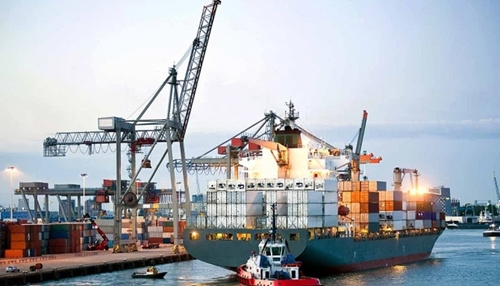The country’s trade turnover during January-February topped some 95.81 billion USD, a year-on-year surge of 25.4 percent. Of the total, exports amounted to 48.55 billion USD, a yearly hike of 23.2 percent, while imports were estimated at 47.26 billion USD, or 25.9 percent higher than the same time last year.
    |
 |
|
Photo for illustration: vneconomy |
Foreign-invested companies accounted for 76.4 percent, or 37.07 billion USD, of Vietnam’s total export turnover. Meanwhile, the domestic sector shipped abroad 11.48 billion USD worth of products.
There were nine commodities joining the billion-USD export club, including telephones and parts (9.3 billion USD, up 22.8 percent year-on-year); electronics, computers and parts (6.9 billion USD, up 27.3 percent); equipment, machines and parts (5.5 billion USD, up 72.6 percent); footwear (3.2 billion USD, up 15.4 percent); and wood and wooden products (2.4 billion USD, up 51 percent). They made up 73 percent of the country’s export turnover.
Vietnam also saw strong surge in shipments of several agricultural products, such as fruits and vegetables (610 million USD, rising 14.6 percent), rubber (516 million USD, increasing 109.7 percent), cashew (442 million USD, up 21.5 percent), and cassava (256 million USD, hiking 78.2 percent).
The U.S. was Vietnam’s biggest importer as it splashed out 14.2 billion USD on Vietnamese products, or 38.2 percent higher than the amount it spent the same time last year. China came second with 8.5 billion USD, followed by the E.U. with 6.3 billion USD, ASEAN 4.2 billion USD, the Republic of Korea 3.4 billion USD, and Japan 3.2 billion USD.
Meanwhile, the country spent big (47.26 billion USD) on imports, with foreign-invested sector purchasing 31.64 billion USD worth of products from abroad for production, up 31.4 percent, while that of the domestic sector surged 16 percent to 15.62 billion USD.
In the two-month period, China was the largest exporter of Vietnam, with revenue estimated at 17.3 billion USD, up 85.7 percent year-on-year, followed by the Republic of Korea with 8.4 billion USD, ASEAN 5.6 billion USD, Japan 3.1 billion USD, EU 2.3 billion USD, and the U.S. 2.1 billion USD.
In a bid to support local firms in promoting production and exports, the Ministry of Industry and Trade said that it will work to capitalise on opportunities from the signed free trade agreements to seek measures for market development. Additionally, it will keep close watch on the global market to identify key export products, while paying due heed to penning measures for market development.
Source: VNA